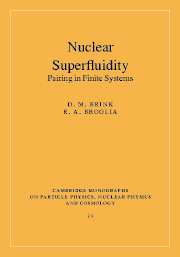Book contents
- Frontmatter
- Contents
- Preface
- 1 Introduction
- 2 The pairing force and seniority
- 3 The BCS theory
- 4 Spontaneous symmetry breaking
- 5 Pairing vibrations
- 6 Phase transitions
- 7 Plastic behaviour of nuclei and other finite systems
- 8 Sources of pairing in nuclei
- 9 Beyond mean field
- 10 Induced interaction
- 11 Pairing in exotic nuclei
- Appendix A A brief résumé of second quantization
- Appendix B Single particle in a non-local potential
- Appendix C Useful relations in the treatment of collective modes
- Appendix D Particle-vibration coupling
- Appendix E Model of the single-particle strength function
- Appendix F Simple model of Pauli principle corrections
- Appendix G Pairing mean-field solution
- Appendix H Pairing in a single j-shell
- Appendix I Fluctuations and symmetry restoration
- Appendix J RPA solution of the pairing Hamiltonian
- Appendix K Vortices in nuclei
- Appendix L Josephson effect
- References
- Index
5 - Pairing vibrations
Published online by Cambridge University Press: 17 August 2009
- Frontmatter
- Contents
- Preface
- 1 Introduction
- 2 The pairing force and seniority
- 3 The BCS theory
- 4 Spontaneous symmetry breaking
- 5 Pairing vibrations
- 6 Phase transitions
- 7 Plastic behaviour of nuclei and other finite systems
- 8 Sources of pairing in nuclei
- 9 Beyond mean field
- 10 Induced interaction
- 11 Pairing in exotic nuclei
- Appendix A A brief résumé of second quantization
- Appendix B Single particle in a non-local potential
- Appendix C Useful relations in the treatment of collective modes
- Appendix D Particle-vibration coupling
- Appendix E Model of the single-particle strength function
- Appendix F Simple model of Pauli principle corrections
- Appendix G Pairing mean-field solution
- Appendix H Pairing in a single j-shell
- Appendix I Fluctuations and symmetry restoration
- Appendix J RPA solution of the pairing Hamiltonian
- Appendix K Vortices in nuclei
- Appendix L Josephson effect
- References
- Index
Summary
When the strength G of the pairing interaction is greater than a critical value Gc, the gap equation has a non-zero solution for the gap parameter Δ and the BCS ground state of a system of nucleons is stable. Single nucleon levels are partially occupied in an energy range Δ around the Fermi energy λ. The BCS state is not an eigenstate of nucleon number and violates gauge invariance. Pairing vibrations, which are fluctuations about the BCS state, were studied in Chapter 4 and it was shown that gauge invariance was restored within the framework of the random phase approximation (RPA). In this chapter we study the question of pairing vibrations within a more general context, considering also pairing vibrations in normal nuclei which have pairing strengths G < Gc and Δ = 0. To a first approximation single-particle levels are occupied with unit probability up to the Fermi energy and with zero probability for states above the Fermi level. Pairing vibrations modify this simple picture and are associated with fields which change the number of particles by 2. They produce correlations which enhance or modify pair transfer amplitudes. Parts of this chapter is based on Broglia and Riedel (1967a,b) and Broglia et al. (1973) (see also Anderson (1958), Högaasen-Feldman (1961), Bes and Broglia (1966), Bohr and Mottelson (1975), Ring and Schuck (1980), Wölfle (1972, 1978), Schmidt (1972)).
- Type
- Chapter
- Information
- Nuclear SuperfluidityPairing in Finite Systems, pp. 92 - 116Publisher: Cambridge University PressPrint publication year: 2005



